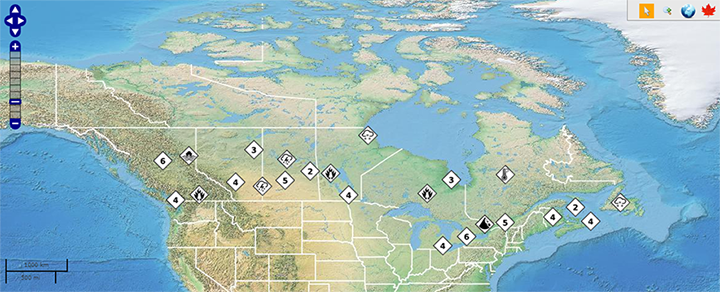Earthquakes
Earthquakes are perhaps the most dangerous of all natural hazards. They resulted in the loss of more than a million lives worldwide during the 20th century. Though they are not widely recognized here as a major hazard, each year more than 50 earthquakes occur that are strong enough to be felt by Canadians. A further 1,400 smaller earthquakes are recorded each year by sensitive monitoring equipment. Both the West Coast and St. Lawrence Valley are at significant risk of a major earthquake.
Many large earthquakes have occurred in Canada's short history. Earthquakes in Cornwall, Ontario in 1944; on southern Vancouver Island, British Columbia in 1946; and in the Saguenay region of Quebec in 1988, have tallied up millions of dollars in damage. Past events have not resulted in greater property damage and heavier casualties primarily because a large earthquake has yet to strike a heavily populated area.
The presence just off our Pacific Coast of an active boundary between tectonic plates makes western Canada subject to frequent and violent activity. Structurally-damaging earthquakes can be expected to strike somewhere in southwestern British Columbia each decade.
Shifting far below ground shakes the surface above
In southeastern Canada, the slow movement of the North American plate southwestwards at a few centimetres per year creates sufficient stresses to cause earthquakes along faults or zones of weakness (such as along the St. Lawrence and Ottawa valleys and the Atlantic seaboard).
In northern Canada, earthquakes are related not only to zones of weakness but to the slow, inevitable rising of the land as it continues to decompress from the weight of the last major ice sheet. This uplift occurs at different rates in different areas, causing earthquakes.
Although earthquakes cannot be prevented or predicted, their effects can be reduced by constructing buildings to withstand the shaking that might occur.
Seismologists, the scientists who study earthquakes, use a magnitude scale to measure the amount of energy released by an earthquake. Although each earthquake has a unique magnitude, its effects will vary greatly according to distance to the epicentre, ground conditions, building age and other factors. For the same magnitude, eastern earthquakes are often more damaging than western earthquakes. A Richter magnitude of less than 3.5 is generally not felt. Magnitude 5.5 to 6.0 will cause slight damage to nearby buildings but a magnitude of 7.0 or more is a major earthquake that could cause wide-spread damage.
For further information on specific events, see the Canadian Disaster Database.
To learn more about how individuals can get better prepared to cope with natural hazards, check out the information available from GetPrepared.
Emergency Management News Releases
Emergency Management Publications and Reports
- Government of Canada Response to the Public Order Emergency Commission Recommendations
- Advancing the Federal-Provincial-Territorial Emergency Management Strategy: Areas for Action
- Evaluation of the Initiatives to Address Post-Traumatic Stress Injuries (PTSI) Evaluation Report
- Summary of the Evaluation of the Initiatives to Address Post-Traumatic Stress Injuries (PTSI) Among Public Safety Officers
- The First Public Report of the National Risk Profile
- Date modified:
